Taurine Alleviates Cadmium-Induced Toxicity via Genetically Specific Strategies in Two Strains of Gibel Carp (Carassius gibelio)
Abstract
:1. Introduction
2. Materials and Methods
2.1. Experimental Procedures
2.2. Sample Collection
2.3. Transmission Electron Microscopy (TEM) Observation
2.4. TUNEL Analysis
2.5. Chemical and Biochemical Analyses
2.6. qRT-PCR Analysis
2.7. Statistical Analysis
3. Results
3.1. Growth Performance
3.2. Histological Observation
3.3. Activities of the Antioxidant and Caspase Enzymes
3.4. Antioxidant Pathways and Metallothionein Levels
3.5. ER Stress
3.6. Autophagy and Apoptosis
3.7. Heatmap Cluster Analysis
4. Discussion
5. Conclusions
Author Contributions
Funding
Institutional Review Board Statement
Informed Consent Statement
Data Availability Statement
Acknowledgments
Conflicts of Interest
References
- Patra, R.C.; Rautray, A.K.; Swarup, D. Oxidative Stress in Lead and Cadmium Toxicity and Its Amelioration. Vet. Med. Int. 2011, 2011, 457327. [Google Scholar] [CrossRef] [PubMed] [Green Version]
- Ninkov, M.; Popov Aleksandrov, A.; Demenesku, J.; Mirkov, I.; Mileusnic, D.; Petrovic, A.; Grigorov, A.; Zolotarevski, L.; Tolinacki, M.; Kataranovski, D.; et al. Toxicity of oral cadmium intake: Impact on gut im-munity. Toxicol. Lett. 2015, 237, 89–99. [Google Scholar] [CrossRef] [PubMed]
- Wright, D.A.; Welbourn, P.M. Cadmium in the aquatic environment: A review of ecological, physiological, and toxicological effects on biota. Environ. Rev. 1994, 2, 187–214. [Google Scholar] [CrossRef]
- Deforest, D.K.; Meyer, J.S. Critical review: Toxicity of dietborne metals to aquatic organisms. Crit. Rev. Environ. Sci. Technol. 2015, 45, 1176–1241. [Google Scholar] [CrossRef]
- Driessnack, M.K.; Jamwal, A.; Niyogi, S. Effects of chronic waterborne cadmium and zinc interactions on tissue-specific metal accumulation and reproduction in fathead minnow (Pimephales promelas). Ecotoxicol. Environ. Saf. 2017, 140, 65–75. [Google Scholar] [CrossRef]
- Basha, P.S.; Rani, A.U. Cadmium-induced antioxidant defense mechanism in freshwater teleost Oreochromis mossambicus (Tilapia). Ecotoxicol. Environ. Saf. 2003, 56, 218–221. [Google Scholar] [CrossRef]
- Defo, M.A.; Bernatchez, L.; Campbell, P.G.C.; Couture, P. Waterborne cadmium and nickel impact oxidative stress responses and retinoid metabolism in yellow perch. Aquat. Toxicol. 2014, 154, 207–220. [Google Scholar] [CrossRef]
- Isani, G.; Andreani, G.; Cocchioni, F.; Fedeli, D.; Carpené, E.; Falcioni, G. Cadmium accumulation and biochemical responses in Sparus aurata following sub-lethal Cd exposure. Ecotoxicol. Environ. Saf. 2009, 72, 224–230. [Google Scholar] [CrossRef]
- Li, H.; Xu, W.; Wu, L.; Dong, B.; Jin, J.; Han, D.; Zhu, X.; Yang, Y.; Liu, H.; Xie, S. Distinct dietary cadmium toxic effects and defense strategies in two strains of gibel carp (Carassius gibelio) revealed by a comprehensive perspective. Chemosphere 2020, 261, 127597. [Google Scholar] [CrossRef]
- Méndez-Armenta, M.; Ríos, C. Cadmium neurotoxicity. Environ. Toxicol. Pharmacol. 2007, 23, 350–358. [Google Scholar] [CrossRef]
- Lawal, A.O.; Ellis, E.M. The chemopreventive effects of aged garlic extract against cadmium-induced toxicity. Environ. Toxicol. Pharmacol. 2011, 32, 266–274. [Google Scholar] [CrossRef] [PubMed]
- Obioha, U.E.; Suru, S.M.; Ola-Mudathir, K.F.; Faremi, T.Y. Hepatoprotective Potentials of Onion and Garlic Extracts on Cadmium-Induced Oxidative Damage in Rats. Biol. Trace Elem. Res. 2008, 129, 143. [Google Scholar] [CrossRef] [PubMed]
- Cuypers, A.; Plusquin, M.; Remans, T.; Jozefczak, M.; Keunen, E.; Gielen, H.; Opdenakker, K.; Nair, A.R.; Munters, E.; Artois, T.J.; et al. Cadmium stress: An oxidative challenge. BioMetals 2010, 23, 927–940. [Google Scholar] [CrossRef] [PubMed]
- Lucia, M.; André, J.-M.; Gonzalez, P.; Baudrimont, M.; Bernadet, M.-D.; Gontier, K.; Maury-Brachet, R.; Guy, G.; Davail, S. Effect of dietary cadmium on lipid metabolism and storage of aquatic bird Cairina moschata. Ecotoxicology 2009, 19, 163. [Google Scholar] [CrossRef] [PubMed]
- El-Sayed, Y.S.; El-Gazzar, A.M.; El-Nahas, A.F.; Ashry, K.M. Vitamin C modulates cadmium-induced hepatic antioxidants’ gene transcripts and toxicopathic changes in Nile tilapia, Oreochromis niloticus. Environ. Sci. Pollut. Res. 2016, 23, 1664–1670. [Google Scholar] [CrossRef]
- Hano, T.; Ito, K.; Kono, K.; Ito, M.; Ohkubo, N.; Mochida, K. Effect of taurine supplementation on hepatic metabolism and alleviation of cadmium toxicity and bioaccumulation in a marine teleost, red sea bream, Pagrus major. Fish Physiol. Biochem. 2017, 43, 137–152. [Google Scholar] [CrossRef]
- Sampath, W.W.H.A.; Rathnayake, R.M.D.S.; Yang, M.; Zhang, W.; Mai, K. Roles of dietary taurine in fish nutrition. Mar. Life Sci. Technol. 2020, 2, 360–375. [Google Scholar] [CrossRef]
- Jong, C.J.; Azuma, J.; Schaffer, S. Mechanism underlying the antioxidant activity of taurine: Prevention of mitochondrial oxidant production. Amino Acids 2012, 42, 2223–2232. [Google Scholar] [CrossRef]
- Takeuchi, T. Progress on larval and juvenile nutrition to improve the quality and health of seawater fish: A review. Fish. Sci. 2014, 80, 389–403. [Google Scholar] [CrossRef] [Green Version]
- Yu, X.; Chen, K.; Wei, N.; Zhang, Q.; Liu, J.; Mi, M. Dietary taurine reduces retinal damage produced by photochemical stress via antioxidant and anti-apoptotic mechanisms in Sprague-Dawley rats. Br. J. Nutr. 2007, 98, 711–719. [Google Scholar] [CrossRef] [Green Version]
- El-Sayed, W.M.; Al-Kahtani, M.A.; Abdel-Moneim, A.M. Prophylactic and therapeutic effects of taurine against aluminum-induced acute hepatotoxicity in mice. J. Hazard. Mater. 2011, 192, 880–886. [Google Scholar] [CrossRef] [PubMed]
- Hwang, D.F.; Wang, L.C.; Cheng, H.M. Effect of taurine on toxicity of copper in rats. Food Chem. Toxicol. 1998, 36, 239–244. [Google Scholar] [CrossRef]
- Hwang, D.F.; Wang, L.C. Effect of taurine on toxicity of cadmium in rats. Toxicology 2001, 167, 173–180. [Google Scholar] [CrossRef]
- Kumar, P.; Prasad, Y.; Patra, A.K.; Ranjan, R.; Swarup, D.; Patra, R.C.; Pal, S. Ascorbic acid, garlic extract and taurine alleviate cadmium-induced oxidative stress in freshwater catfish (Clarias batrachus). Sci. Total Environ. 2009, 407, 5024–5030. [Google Scholar] [CrossRef]
- Li, H.; Xu, W.; Wu, L.; Dong, B.; Jin, J.; Han, D.; Zhu, X.; Yang, Y.; Liu, H.; Xie, S. Differential regulation of endoplasmic reticulum stress-induced autophagy and apoptosis in two strains of gibel carp (Carassius gibelio) exposed to acute waterborne cadmium. Aquat. Toxicol. 2021, 231, 105721. [Google Scholar] [CrossRef] [PubMed]
- Andres, S.; Ribeyre, F.; Tourencq, J.-N.; Boudou, A. Interspecific comparison of cadmium and zinc contamination in the organs of four fish species along a polymetallic pollution gradient (Lot River, France). Sci. Total Environ. 2000, 248, 11–25. [Google Scholar] [CrossRef]
- Potter, B. Liver-Intermediary Metabolism. In xPharm: The Comprehensive Pharmacology Reference; Enna, S.J., Bylund, D.B., Eds.; Elsevier: New York, NY, USA, 2007; pp. 1–6. [Google Scholar]
- Li, H.; Xu, W.; Jin, J.; Zhu, X.; Yang, Y.; Han, D.; Liu, H.; Xie, S. Effects of dietary carbohydrate and lipid concentrations on growth performance, feed utilization, glucose, and lipid metabolism in two strains of gibel carp. Front. Vet. Sci. 2019, 6, 165. [Google Scholar] [CrossRef]
- Pfaffl, M.W. A new mathematical model for relative quantification in real-time RT-PCR. Nucleic Acids Res. 2001, 29, e45. [Google Scholar] [CrossRef]
- Yue, Y.; Liu, Y.; Tian, L.; Gan, L.; Yang, H.; Liang, G.; He, J. The effect of dietary taurine supplementation on growth performance, feed utilization and taurine contents in tissues of juvenile white shrimp (Litopenaeus vannamei, Boone, 1931) fed with low-fishmeal diets. Aquac. Res. 2013, 44, 1317–1325. [Google Scholar] [CrossRef]
- Zhang, J.; Hu, Y.; Ai, Q.; Mao, P.; Tian, Q.; Zhong, L.; Xiao, T.; Chu, W. Effect of dietary taurine supplementation on growth performance, digestive enzyme activities and antioxidant status of juvenile black carp (Mylopharyngodon piceus) fed with low fish meal diet. Aquac. Res. 2018, 49, 3187–3195. [Google Scholar] [CrossRef]
- Matsunari, H.; Takeuchi, T.; Takahashi, M.; Mushiake, K. Effect of dietary taurine supplementation on growth performance of yellowtail juveniles Seriola quinqueradiata. Fish. Sci. 2005, 71, 1131–1135. [Google Scholar] [CrossRef]
- Al-Feky, S.S.A.; El-Sayed, A.-F.M.; Ezzat, A.A. Dietary taurine enhances growth and feed utilization in larval Nile tilapia (Oreochromis niloticus) fed soybean meal-based diets. Aquac. Nutr. 2016, 22, 457–464. [Google Scholar] [CrossRef]
- Stohs, S.J.; Bagchi, D. Oxidative mechanisms in the toxicity of metal ions. Free Radic. Biol. Med. 1995, 18, 321–336. [Google Scholar] [CrossRef] [Green Version]
- Dang, F.; Wang, W.X. Assessment of tissue-specific accumulation and effects of cadmium in a marine fish fed contaminated commercially produced diet. Aquat. Toxicol. 2009, 95, 248–255. [Google Scholar] [CrossRef] [PubMed]
- Hisar, O.; Yildirim, S.; Sönmez, A.Y.; Aras, H.N.; Gultepe, N. Changes in liver and kidney antioxidant enzyme activities in the rainbow trout (Oncorhynchus mykiss) exposed cadmium. Asian J. Chem. 2009, 21, 3133–3139. [Google Scholar]
- Asagba, S.O.; Eriyamremu, G.E.; Igberaese, M.E. Bioaccumulation of cadmium and its biochemical effect on selected tissues of the catfish (Clarias gariepinus). Fish Physiol. Biochem. 2008, 34, 61–69. [Google Scholar] [CrossRef] [PubMed]
- Liu, X.-J.; Luo, Z.; Li, C.-H.; Xiong, B.-X.; Zhao, Y.-H.; Li, X.-D. Antioxidant responses, hepatic intermediary metabolism, histology and ultrastructure in Synechogobius hasta exposed to waterborne cadmium. Ecotoxicol. Environ. Saf. 2011, 74, 1156–1163. [Google Scholar] [CrossRef] [PubMed]
- Wu, K.C.; Liu, J.J.; Klaassen, C.D. Nrf2 activation prevents cadmium-induced acute liver injury. Toxicol. Appl. Pharmacol. 2012, 263, 14–20. [Google Scholar] [CrossRef]
- Mizunoe, Y.; Kobayashi, M.; Sudo, Y.; Watanabe, S.; Yasukawa, H.; Natori, D.; Hoshino, A.; Negishi, A.; Okita, N.; Komatsu, M.; et al. Trehalose protects against oxidative stress by regulating the Keap1–Nrf2 and autophagy pathways. Redox Biol. 2018, 15, 115–124. [Google Scholar] [CrossRef]
- Wang, L.; Gallagher, E.P. Role of Nrf2 antioxidant defense in mitigating cadmium-induced oxidative stress in the olfactory system of zebrafish. Toxicol. Appl. Pharmacol. 2013, 266, 177–186. [Google Scholar] [CrossRef]
- Cao, S.S.; Kaufman, R.J. Endoplasmic Reticulum Stress and Oxidative Stress in Cell Fate Decision and Human Disease. Antioxid. Redox Signal. 2014, 21, 396–413. [Google Scholar] [CrossRef] [PubMed]
- Wu, K.; Luo, Z.; Hogstrand, C.; Chen, G.; Wei, C.; Li, D. Zn Stimulates the phospholipids biosynthesis via the pathways of oxidative and endoplasmic reticulum stress in the intestine of freshwater teleost yellow catfish. Environ. Sci. Technol. 2018, 52, 9206–9214. [Google Scholar] [CrossRef] [Green Version]
- Cullinan, S.B.; Zhang, D.; Hannink, M.; Arvisais, E.; Kaufman, R.J.; Diehl, J.A. Nrf2 Is a Direct PERK Substrate and Effector of PERK-Dependent Cell Survival. Mol. Cell. Biol. 2003, 23, 7198–7209. [Google Scholar] [CrossRef] [PubMed] [Green Version]
- Kaur, J.; Debnath, J. Autophagy at the crossroads of catabolism and anabolism. Nat. Rev. Mol. Cell Biol. 2015, 16, 461–472. [Google Scholar] [CrossRef] [Green Version]
- Ogata, M.; Hino, S.-I.; Saito, A.; Morikawa, K.; Kondo, S.; Kanemoto, S.; Murakami, T.; Taniguchi, M.; Tanii, I.; Yoshinaga, K.; et al. Autophagy Is Activated for Cell Survival after Endoplasmic ReticulumStress. Am. Soc. Microbiol. 2006, 26, 9220–9231. [Google Scholar] [CrossRef] [PubMed] [Green Version]
- Zhang, L.; Xia, Q.; Zhou, Y.; Li, J. Endoplasmic reticulum stress and autophagy contribute to cadmium-induced cytotoxicity in retinal pigment epithelial cells. Toxicol. Lett. 2019, 311, 105–113. [Google Scholar] [CrossRef]
- Wang, M.; Wang, X.; Li, Y.; Chen, N.; Fan, Y.; Huang, W.; Hu, S.; Rao, M.; Zhang, Y.; Su, P. Cross-talk between autophagy and apoptosis regulates testicular injury/recovery induced by cadmium via PI3K with mTOR-independent pathway. Cell Death Dis. 2020, 11, 46. [Google Scholar] [CrossRef] [Green Version]
- Agnello, M.; Roccheri, M.C. Apoptosis: Focus on sea urchin development. Apoptosis 2010, 15, 322–330. [Google Scholar] [CrossRef]
- Capaldo, A.; Gay, F.; Scudiero, R.; Trinchella, F.; Caputo, I.; Lepretti, M.; Marabotti, A.; Esposito, C.; Laforgia, V. Histological changes, apoptosis and metallothionein levels in Triturus carnifex (Amphibia, Urodela) exposed to environmental cadmium concentrations. Aquat. Toxicol. 2016, 173, 63–73. [Google Scholar] [CrossRef]
- Gao, D.; Xu, Z.E.; Qiao, P.; Liu, S.; Zhang, L.; He, P.; Zhang, X.; Wang, Y.; Min, W. Cadmium induces liver cell apoptosis through caspase-3a activation in purse red common carp (Cyprinus carpio). PLoS ONE 2013, 8, e83423. [Google Scholar]
- Rose, W.L.; Nisbet, R.M.; Green, P.G.; Norris, S.; Fan, T.; Smith, E.H.; Cherr, G.N.; Anderson, S.L. Using an integrated approach to link biomarker responses and physiological stress to growth impairment of cadmium-exposed larval topsmelt. Aquat. Toxicol. 2006, 80, 298–308. [Google Scholar] [CrossRef]
- Redza-Dutordoir, M.; Averill-Bates, D.A. Activation of apoptosis signalling pathways by reactive oxygen species. Biochim. Biophys. Acta Mol. Cell Res. 2016, 1863, 2977–2992. [Google Scholar] [CrossRef]
- Chang, C.; Yeh, M.; Lin, H.; Cheng, W. The effect of Vibrio alginolyticus infection on caspase-3 expression and activity in white shrimp Litopenaeus vannamei. Fish Shellfish. Immunol. 2008, 25, 672–678. [Google Scholar] [CrossRef]
- Song, S.; Tan, J.; Miao, Y.; Li, M.; Zhang, Q. Crosstalk of autophagy and apoptosis: Involvement of the dual role of autophagy under ER stress. J. Cell. Physiol. 2017, 232, 2977–2984. [Google Scholar] [CrossRef]
- Gao, F.-X.; Wang, Y.; Zhang, Q.-Y.; Mou, C.-Y.; Li, Z.; Deng, Y.-S.; Zhou, L.; Gui, J.-F. Distinct herpesvirus resistances and immune responses of three gynogenetic clones of gibel carp revealed by comprehensive transcriptomes. BMC Genom. 2017, 18, 561. [Google Scholar] [CrossRef]
- Chen, F.; Li, X.-Y.; Zhou, L.; Yu, P.; Wang, Z.-W.; Li, Z.; Zhang, X.-J.; Wang, Y.; Gui, J.-F. Stable Genome Incorporation of Sperm-derived DNA Fragments in Gynogenetic Clone of Gibel Carp. Mar. Biotechnol. 2020, 22, 54–66. [Google Scholar] [CrossRef]
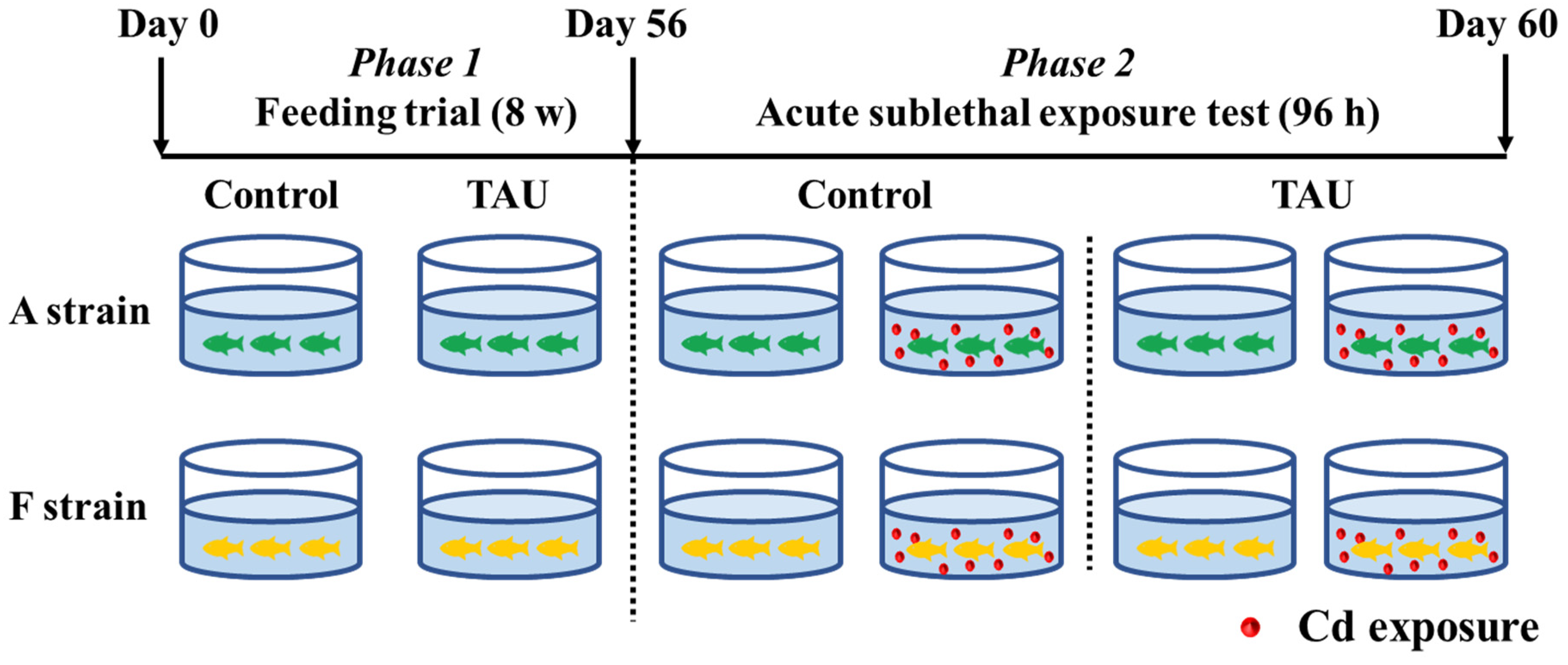


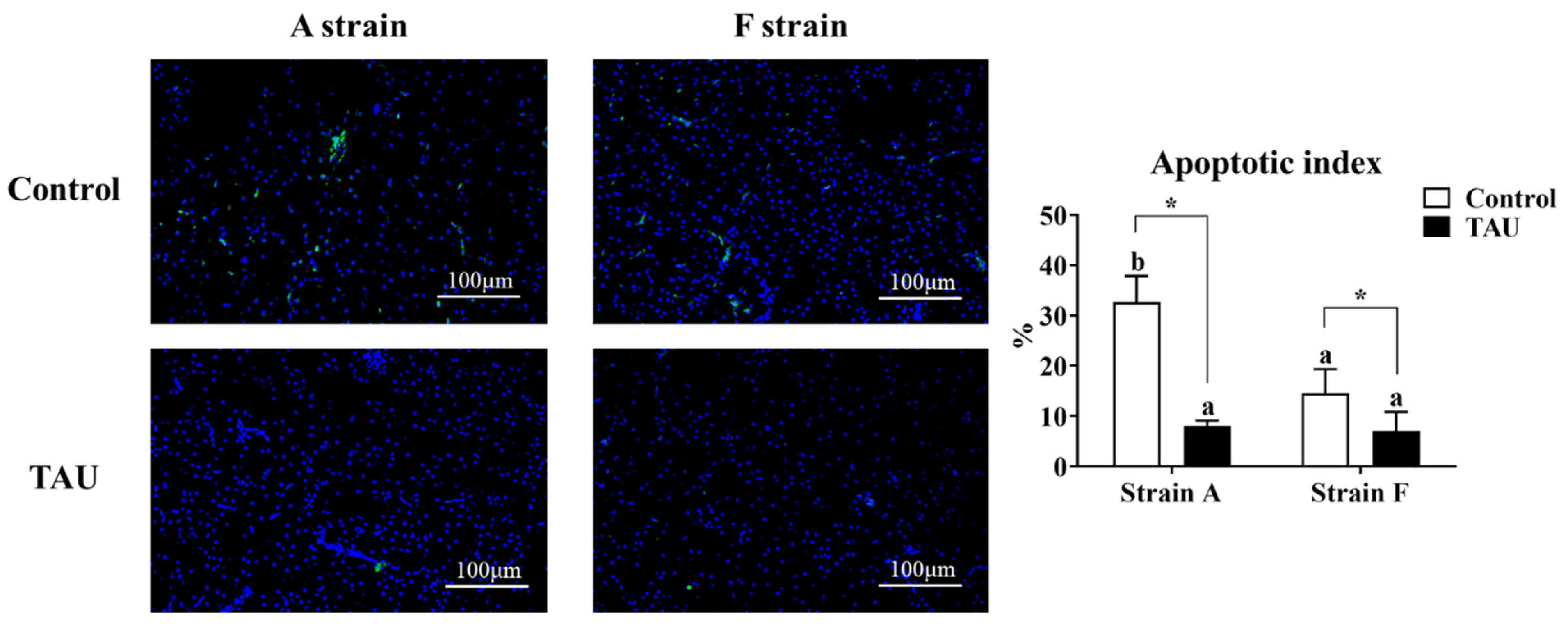
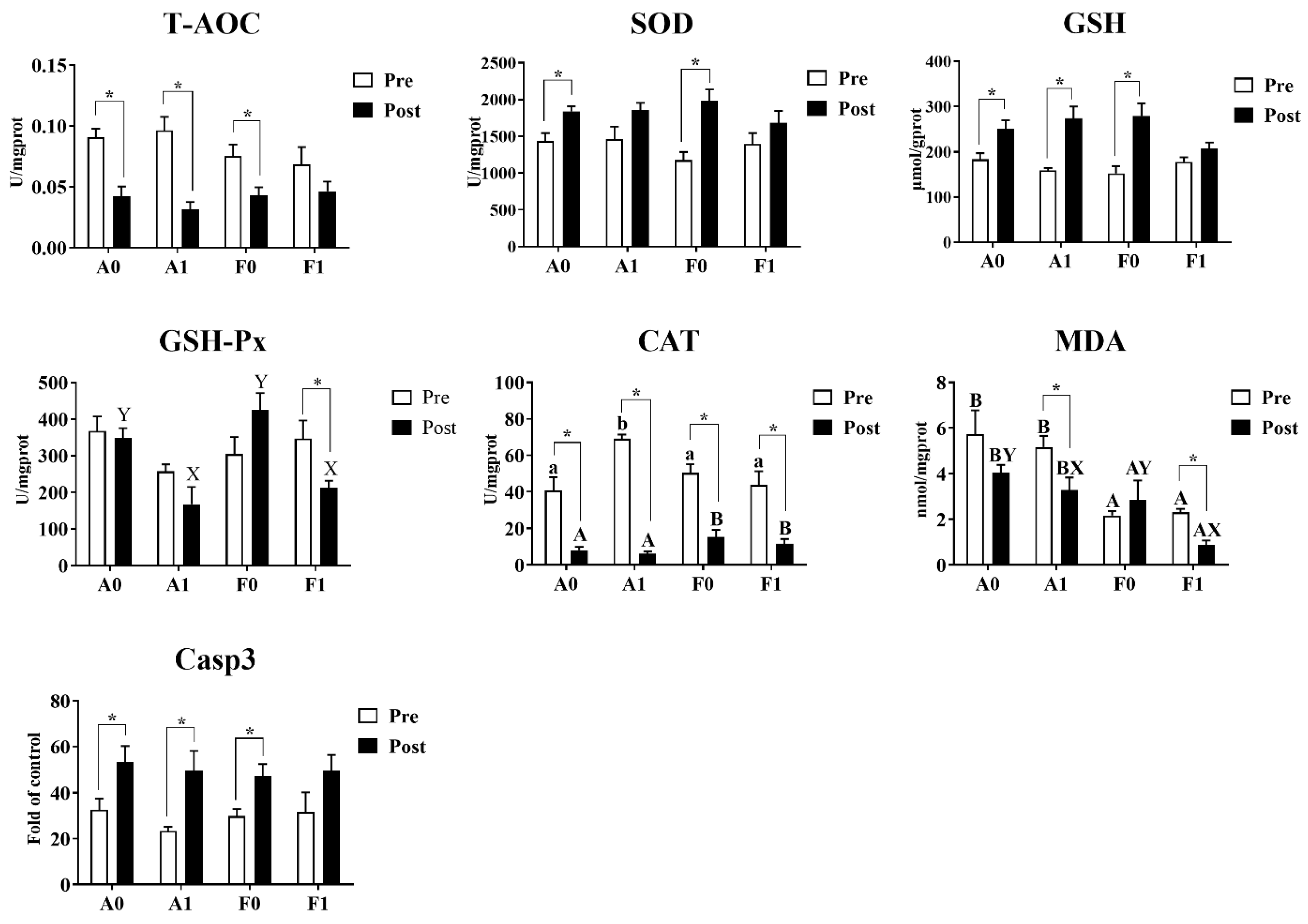

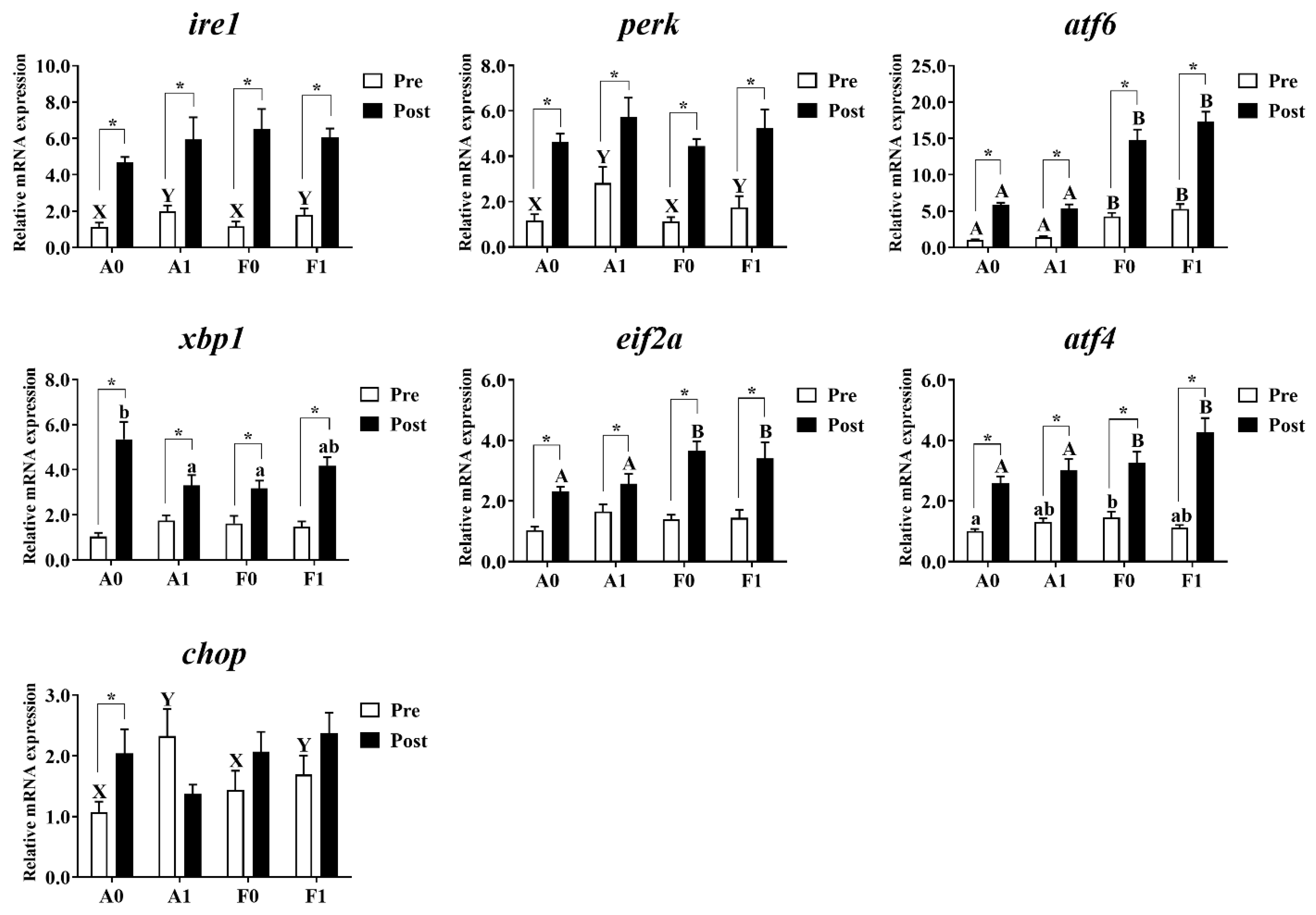
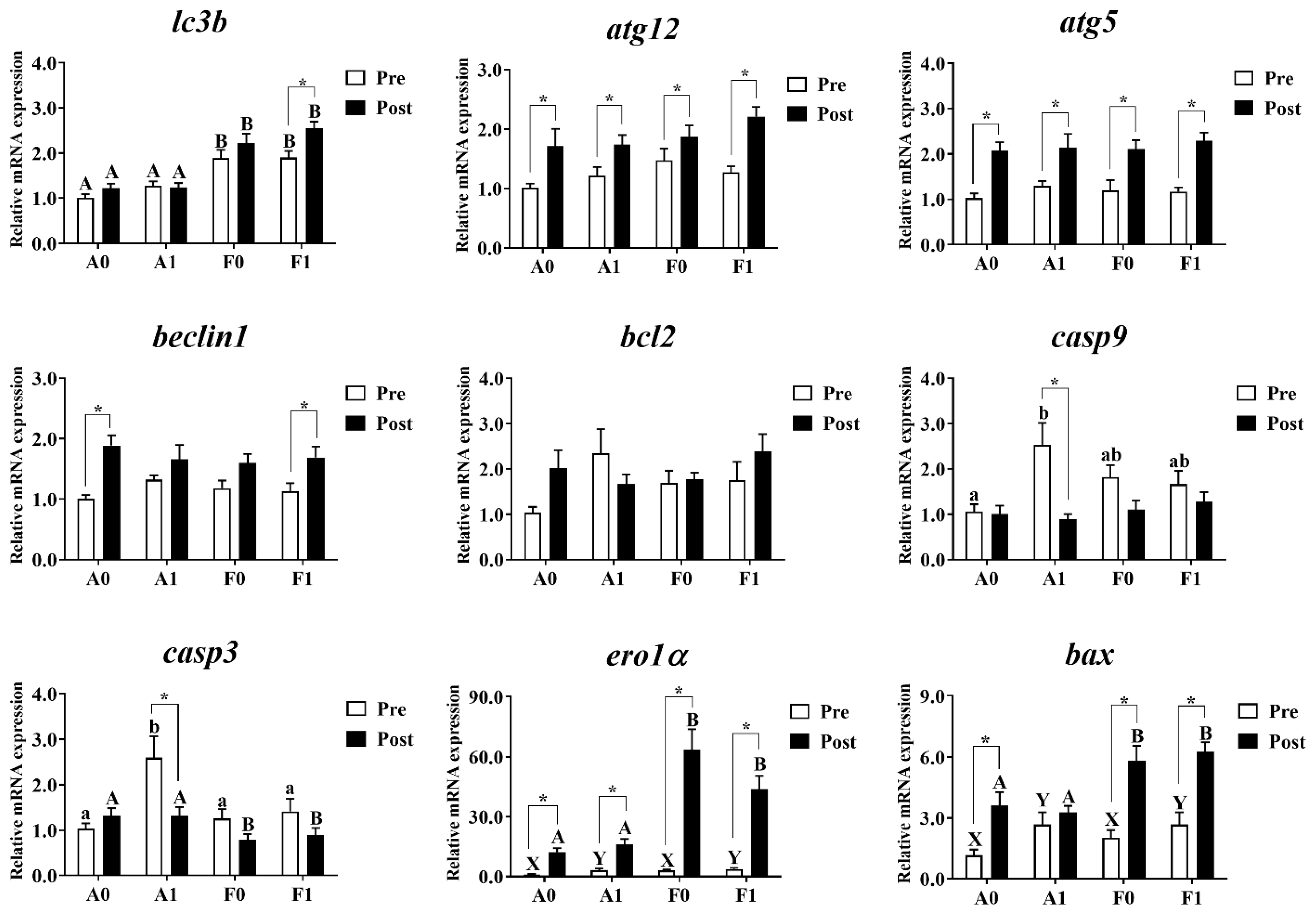
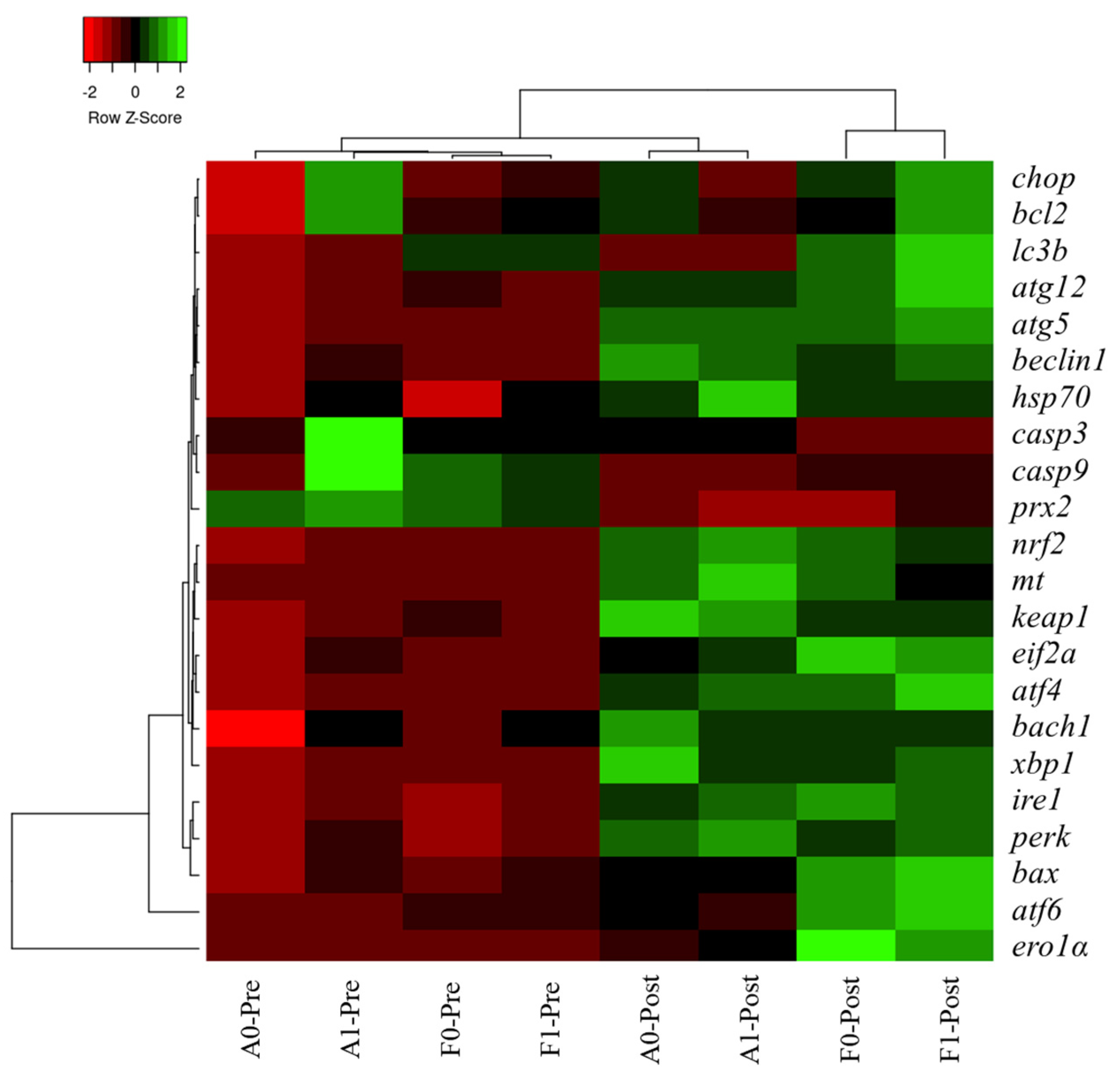
| Ingredients | Control | TAU |
|---|---|---|
| White fishmeal 1 | 100 | 100 |
| Wheat gluten | 100 | 100 |
| Soybean meal 2 | 170 | 170 |
| Rapeseed meal 2 | 170 | 170 |
| Fish oil | 33 | 33 |
| Soybean oil | 33 | 33 |
| Wheat flour | 250 | 250 |
| Taurine | 0 | 10 |
| Vitamin premix 3 | 3.9 | 3.9 |
| Choline chloride | 1.1 | 1.1 |
| Mineral premix 4 | 50 | 50 |
| CMC | 30 | 30 |
| Cellulose | 59 | 59 |
| Chemical composition (g/kg) | ||
| Crude protein | 340.5 | 344.0 |
| Crude lipid | 82.5 | 80.2 |
| Ash | 74.8 | 74.6 |
| Moisture | 79.3 | 88.1 |
| Gene | Acronym | Prime Sequence | Amplicon Size (bp) | Accession No. |
|---|---|---|---|---|
| Tubulin | tubulin | TCCTTCAACACCTTCTTCAGTGAGAC | 134 | JX4135181 |
| AGCTGCTCAGGGTGGAACAGC | ||||
| Nuclear factor [erythroid-derived 2]-like 2 | nrf2 | CCCTTCACCAAAGACAAGCA | 128 | MG759384 |
| TTGAAGTCATCCACAGGCAG | ||||
| Kelch-like ECH-associated protein-1 | keap1 | CTCACCCCCAACTTCCTGCAG | 150 | MG759382 |
| GATGAGCTGCGGCACCTTGGG | ||||
| CNC homolog 1 | bach1 | TGGAGCGCAGGAGCTTTCGAG | 98 | XM_026282740 |
| AGTGGGGTTTGGTCGGCTGTG | ||||
| Peroxiredoxin 2 | prx2 | AGGTCATCGCTGCTTCCACCG | 90 | XM_026211451 |
| TGTTCATGGAGCCCAGGCCAC | ||||
| Heat shock protein 70 | hsp70 | CTCAACAAGAGCATCAACCCAG | 155 | JN006055.1 |
| ATGACTCCACCAGCCGTTTC | ||||
| Metallothionein | mt | AACTTGTTCGTCTGTGCTGG | 93 | XM_026230631.1 |
| GAGAACAACAGGGAGGTCGT | ||||
| Activating transcription factor 6 | atf6 | TGCAGGTGTATTACGCCCCTCAC | 176 | XM_026290872.1 |
| GTAATTCATAGCTGGCAGGACCAC | ||||
| Eukaryotic translation initiation factor 2A | eif2a | AGCTGCCAAAGAACGGCCCCATT | 226 | XM_026230526.1 |
| CAAACTTCCATCTGCCCTCTCAG | ||||
| Inositol-requiring protein-1α | ire1 | GCGACCTTTCCTGCCTTACT | 253 | XM_026218282.1 |
| AGTCTCCTGTTTGGACAGCG | ||||
| X-box-binding protein 1 | xbp1 | CATCTACACCAAACCCACCGA | 264 | MN852578 |
| CATCCAGAGTCACTGTACGCA | ||||
| Eukaryotic translation initiation factor 2-alpha kinase 3 | perk | TGCCATCAAGAGGATCCGTCTGC | 122 | XM_026224076.1 |
| CCTGCCAAGCATTGAAGTAACGG | ||||
| Activating transcription factor 4 | atf4 | CAGCCGAGAGATCCGCTATC | 215 | XM_026260813.1 |
| GATGAGCCCCTTACTGGACG | ||||
| DNA damage-inducible transcript 3 protein | chop | ACCACTCCTCGCTGACAGA | 88 | XM_026265784.1 |
| TTAGAGGCCTCGGGTCGAT | ||||
| Endoplasmic reticulum oxidoreductase 1 alpha | ero1α | ATGCCCAACACAAGCAACAC | 129 | XM_026242578.1 |
| TGACAACAGCGACCGAAAGT | ||||
| Microtubule-associated proteins 1A/1B light chain 3B | lc3b | CTACGAGCGCGAGAGAGATG | 81 | XM_026238789.1 |
| TGAGGACACGCAGTTCCAAA | ||||
| Beclin-1 | beclin1 | TGGAGAACTTGAGTCGCAGG | 129 | XM_026249455.1 |
| GCTGAGTGTCCAGATGGTCG | ||||
| Autophagy protein 5 | atg5 | GCTCTTCCGACCAGTGTCTC | 188 | XM_026284696.1 |
| AGTTGTCTGGGTGGCTCAAG | ||||
| Autophagy protein 12 | atg12 | GCTGTTGAAAGCAGTAGGTGATG | 170 | XM_026284438.1 |
| GGTCTGGTGATGGAGCAAATGAC | ||||
| Apoptosis regulator Bcl-2 | bcl2 | AAAGGATGTACCAGCGCGAA | 83 | XM_026237836.1 |
| GGCTAAGAATCTGCGTTGCG | ||||
| BCL2 associated X, apoptosis regulator | bax | ACCCCAGCCATAAACGTCTTGCG | 214 | XM_026262399.1 |
| GCCTTGATGACAAGCCGACAC | ||||
| Caspase 3 | casp3 | ATCATGACCAGGGTCAACCA | 119 | XM_026266756.1 |
| TACATCTCTTTGGTGAGCAT | ||||
| Caspase 9 | casp9 | ATCACAAACTACCTCAACGG | 80 | XM_026241892.1 |
| CCTCCACAGGCCTGGATGAA |
Publisher’s Note: MDPI stays neutral with regard to jurisdictional claims in published maps and institutional affiliations. |
© 2022 by the authors. Licensee MDPI, Basel, Switzerland. This article is an open access article distributed under the terms and conditions of the Creative Commons Attribution (CC BY) license (https://creativecommons.org/licenses/by/4.0/).
Share and Cite
Xu, W.; Li, H.; Wu, L.; Jin, J.; Han, D.; Zhu, X.; Yang, Y.; Liu, H.; Xie, S. Taurine Alleviates Cadmium-Induced Toxicity via Genetically Specific Strategies in Two Strains of Gibel Carp (Carassius gibelio). Antioxidants 2022, 11, 1381. https://doi.org/10.3390/antiox11071381
Xu W, Li H, Wu L, Jin J, Han D, Zhu X, Yang Y, Liu H, Xie S. Taurine Alleviates Cadmium-Induced Toxicity via Genetically Specific Strategies in Two Strains of Gibel Carp (Carassius gibelio). Antioxidants. 2022; 11(7):1381. https://doi.org/10.3390/antiox11071381
Chicago/Turabian StyleXu, Wenjie, Hongyan Li, Liyun Wu, Junyan Jin, Dong Han, Xiaoming Zhu, Yunxia Yang, Haokun Liu, and Shouqi Xie. 2022. "Taurine Alleviates Cadmium-Induced Toxicity via Genetically Specific Strategies in Two Strains of Gibel Carp (Carassius gibelio)" Antioxidants 11, no. 7: 1381. https://doi.org/10.3390/antiox11071381
APA StyleXu, W., Li, H., Wu, L., Jin, J., Han, D., Zhu, X., Yang, Y., Liu, H., & Xie, S. (2022). Taurine Alleviates Cadmium-Induced Toxicity via Genetically Specific Strategies in Two Strains of Gibel Carp (Carassius gibelio). Antioxidants, 11(7), 1381. https://doi.org/10.3390/antiox11071381








